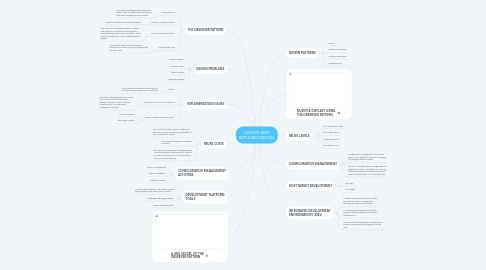DESIGN AND IMPLEMENTATION
by syarifah nur amirah

1. DESIGN PATTERNS
1.1. Name
1.2. Problem Description
1.3. Solution Description
1.4. Consequences
2. MULTIPLE DISPLAYS USING THE OBSERVER PATTERN
3. THE OBSERVER PATTERN
3.1. DESCRIPTION
3.1.1. Separates the display of the state of an object from the object itself and allows alternative displays to be provided.
3.2. PROBLEM DESCRIPTION
3.2.1. Graphical display and a tabular display.
3.3. SOLUTION DESCRIPTION
3.3.1. This involves two abstract objects, Subject and Observer, and two concrete objects, ConcreteSubject and ConcreteObject, which inherit the attributes of the related abstract objects.
3.4. CONSEQUENCES
3.4.1. The subject only knows the abstract Observer and does not know details of the concrete class.
4. DESIGN PROBLEMS
4.1. Observer Pattern
4.2. Facade Pattern
4.3. Iterator Pattern
4.4. Decorator Pattern
5. IMPLEMENTATION ISSUES
5.1. REUSE
5.1.1. Most modern software is constructed by reusing existing components or systems.
5.2. CONFIGURATION MANAGEMENT
5.2.1. During the development process, you have to keep track of the many different versions of each software component in a configuration management system.
5.3. HOST-TARGET DEVELOPMEMT
5.3.1. The Host System
5.3.2. The Target System
6. REUSE LEVELS
6.1. The Abstaction Level
6.2. The Object Level
6.3. Componen Level
6.4. The System Level
7. REUSE COSTS
7.1. The costs of the time spent in looking for software to reuse and assessing whether or not it meets your needs.
7.2. The costs of buying the reusable software.
7.3. The costs of adapting and configuring the reusable software components or systems to reflect the requirements of the system that you are developing.
8. CONFIGURATION MANAGEMENT
8.1. Configuration management is the name given to the general process of managing a changing software system.
8.2. The aim of configuration management is to support the system integration process so that all developers can access the project code and documents in a controlled way.
9. CONFIGURATION MANAGEMENT ACTIVITIES
9.1. Version Management.
9.2. System Integration.
9.3. Problem Tracking.
10. HOST-TARGET DEVELOPMENT
10.1. The Host
10.2. The Target
11. DEVELOPMENT PLATFORM TOOLS
11.1. An integrated compiler and syntax-directed editing system that allows you to create.
11.2. A language debugging system.
11.3. Graphical editing tools.
12. INTEGRATED DEVELOPMENT ENVIRONMENTS (IDEs)
12.1. Software development tools are often grouped to create an integrated development environment (IDE).
12.2. An IDE is a set of software tools that supports different aspects of software development.
12.3. IDEs are created to support development in a specific programming language such as Java.
13. A UML MODEL OF THE OBSERVER PATTERN


